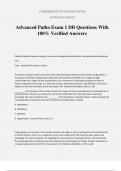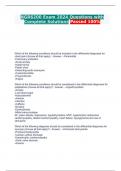©THEBRIGHT EXAM SOLUTIONS
11/05/2024 12:06 PM
Advanced Patho Exam 1 DB Questions With
100% Verified Answers
Passive transport requires energy to move an uncharged molecule across a semipermeable membrane.
True
False - answer✔The answer is False
"In passive transport, water and small, electrically uncharged molecules move easily through pores in
the plasma membrane's lipid bilayer. Molecules will easily flow downhill from a region of high
concentration to a region of low concentration, this movement is called passive because it doesn't
require expenditure of energy. It is driven by osmosis, hydrostatic pressure, and diffusion, all of which
depend on the laws of physics and do not require life" (Brashers & Huether, 2019, p. 28).
_________ is an increase in the number of cells in an organ or tissue resulting from an increased rate of
cellular division. Occurs as a response to injury that results when the injury has been severe and
prolonged. The main mechanism for _________ is the production of growth factors, which stimulate the
remaining cells to synthesize new cell components and ultimately, to divide.
A. Hyperplasia
B. Metaplasia
C. Dysplasia
D. Hypertrophy - answer✔The answer is A
"Hyperplasia is an increase in the number of cells in an organ or tissue resulting from an increased rate
of cellular division. Occurs as a response to injury that results when the injury has been severe and
prolonged. The main mechanism for hyperplasia is the production of growth factors, which stimulate
the remaining cells to synthesize new cell components and ultimately, to divide. Another mechanism is
increased output of new cells from tissue stem cells" (Brashers & Huether, 2019, p. 48).
, ©THEBRIGHT EXAM SOLUTIONS
11/05/2024 12:06 PM
Cancers arising from mesenchymal tissue (including connective tissue, muscle, and bone) usually end in
what suffix?
A. Phoma
B. Kemia
C. Carcinoma
D. Sarcoma - answer✔The answer is D
"Cancers arising from mesenchymal tissue (including connective tissue, muscle, and bone) usually have
the suffix sarcoma" (Brashers & Huether, 2019, p. 347).
Which of the following is a clinical manifestation of Hypocalcemia?
A. Negative Trousseau's sign
B. Tapping on the facial nerve below the temple and the nose/lip twitching
C. Coma
D. Serum Calcium level of 9.4 mg/dl - answer✔THE ANSWER IS B. Tapping on the facial nerve below the
temple and the nose/lip twitching is also known as a positive Cvostek sign. The symptoms of
hypocalcemia are related to neuromuscular irritability. A positive Trousseau's sign would be a
manifestation of hypocalcemia, not a negative one. Serum Calcium level would need to be below 8.5
mg/dl to indicate hypocalcemia.(McCance et al. 2014, p. 120).
Which of the following is NOT a cause of metabolic acidosis?
A. Renal Failure
B. Diarrhea
C. Diabetic Ketoacidosis
, ©THEBRIGHT EXAM SOLUTIONS
11/05/2024 12:06 PM
D. Vomiting - answer✔THE ANSWER IS D. Vomiting would cause Metabolic Alkalosis not Metabolic
Acidosis. Metabolic Acidosis happens when the concentration of non-carbonic acids increases or bicarb
is lost from ECF and cannot be regenerated by the kidney. (McCance et al. 2014, p. 126-127).
_____ refers to abnormal changes in the size, shape, and organization of mature cells.
A. Hypertrophy
B. Metaplasia
C. Hyperplasia
D. Dysplasia - answer✔THE ANSWER IS D. "Dysplasia refers to abnormal changes in the size, shape, and
organization of mature cells" (McCance et al. 2014, p. 53-54).
TRUE or False. The endoplasmic reticulum is a membrane factory that specializes in the synthesis and
transport of the protein and lipid components of most of the cell's organelles. - answer✔Answer: TRUE
Rationale: "The endoplasmic reticulum is a membrane factory that specializes in the synthesis and
transport of the protein and lipid components of most of the cell's organelles. It consists of a network of
tubular or saclike channels that extend throughout the cytoplasm and are continuous with the outer
nuclear membrane" (McCance, K. L., Huether, S.E., Brashers, V. L., and Rote, N. S., 2019).
Which of the following statements are proven to be true about prostate cancer? Select all that apply:
A. Having an affected first-degree relative increases your chance of developing prostate cancer
B. Non-genetic risk factors include high-carbohydrate diet
C. Prostate cancer usually progresses rapidly
D. Prostate cancer can be detected by digital examination and by examining PSA levels
, ©THEBRIGHT EXAM SOLUTIONS
11/05/2024 12:06 PM
E. The mean age of onset for developing prostate cancer is 72 years of age - answer✔Answers: A, D, E
Rationale: Review section over prostate cancer in text. Non-genetic risk factors include high-fat diet.
Prostate cancer usually progresses very slowly. (McCance, K. L., Huether, S.E., Brashers, V. L., and Rote,
N. S., 2019).
Which of the following statements are true about type II diabetes? Select all that apply:
A. Type II diabetes is insulin resistant
B. Type II diabetes in autoimmune
C. Age of onset is usually >40 years
D. Obesity is common with type II diabetes
E. The body does not produce insulin with type II diabetes - answer✔Answers: A, C, D
Rationale: Refer to table 5.7 "Comparison of Major Features of Type 1 and Type 2 Diabetes" (McCance,
K. L., Huether, S.E., Brashers, V. L., and Rote, N. S., 2019).
Your patient presents complaining of tingling, muscle spasms in her feet and intestinal cramping. Upon
examination, you elicit a positive Chvostek sign. These are indicative of
a. Hypercalcemia
b. Hypocalcemia
c. Hyperkalemia
d. Hypokalemia - answer✔Answer: B - Hypocalcemia
Rationale: Manifestations of hypocalcemia include increased neuromuscular excitability, tingling, muscle
spasms in feet and facial muscles, intestinal cramping, increased bowel sounds, osteoporosis and
fractures. Severe hypocalcemia can exhibit convulsions, tetany, a prolonged QT interval and cardiac
arrest. Two clinical signs of hypocalcemia include Chvostek sign and Trousseau sign. The Chvostek sign is





